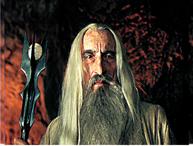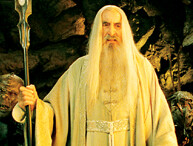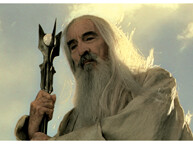Saruman: Difference between revisions
(stubbing this) |
(reorg, and a bunch of interesting trivia) |
||
| Line 1: | Line 1: | ||
The corrupt White Wizard '''Saruman''' is the leader of the White Council and a secret ally to Sauron, and plots to betray one then the other. In this game, he is the only [[Shadow Alignment|Shadow]] [[wizard]], and appears as both a [[minion]] and a [[follower]]. Saruman leads the {{Card|Isengard}} [[culture]], which includes most cards associated with Saruman, including his army of [[Uruk-hai]] and [[orc]]s, as well as corrupt [[Men|men]] like [[Grima]] | The corrupt White Wizard '''Saruman''' is the leader of the White Council and a secret ally to Sauron, and plots to betray one then the other. In this game, he is the only [[Shadow Alignment|Shadow]] [[wizard]], and appears as both a [[minion]] and a [[follower]]. Saruman leads the {{Card|Isengard}} [[culture]], which includes most cards associated with Saruman, including his army of [[Uruk-hai]] and [[orc]]s, as well as corrupt [[Men|men]] like [[Grima]]. | ||
However, befitting his self-applied title "of Many Colours," Saruman also appears on cards in other cultures, representing his capacity as leader and instigator. He's the first character in the game to appear in a second culture, with {{Card|Saruman, Rabble-rouser}}. Along with the [[Balrog]] and [[Maia|Sauron himself]], is one of the few characters who continues to appear in his original culture after the Shadow cultures are reorganized in the [[Shadows]] set. Unlike the Balrog and Sauron, he is the only character who appears in both his original culture as well as the new cultures, as well as the only character who appears in more than one post-Shadows Shadow-alignment culture. | |||
All in all, of all [[unique]] [[character]]s, Saruman appears in the most different cultures: {{C|Isengard}}, {{C|Dunland}}, {{C|Men}}, and {{C|Uruk-hai}} cultures. (The next closest is [[Gothmog, Morgul Commander (8R72)|Gothmog]], who appears in three, followed by [[Aragorn]] and many Shadow characters appearing in two.) | |||
{{PersonaTable|Saruman}} | {{PersonaTable|Saruman}} | ||
[[Category:Unique Characters]] | [[Category:Unique Characters]] | ||
Revision as of 04:10, 2 January 2022
The corrupt White Wizard Saruman is the leader of the White Council and a secret ally to Sauron, and plots to betray one then the other. In this game, he is the only Shadow wizard, and appears as both a minion and a follower. Saruman leads the Isengard
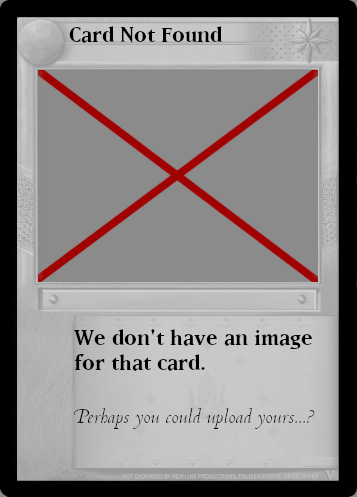 culture, which includes most cards associated with Saruman, including his army of Uruk-hai and orcs, as well as corrupt men like Grima.
culture, which includes most cards associated with Saruman, including his army of Uruk-hai and orcs, as well as corrupt men like Grima.
However, befitting his self-applied title "of Many Colours," Saruman also appears on cards in other cultures, representing his capacity as leader and instigator. He's the first character in the game to appear in a second culture, with Saruman, Rabble-rouser (4R33)
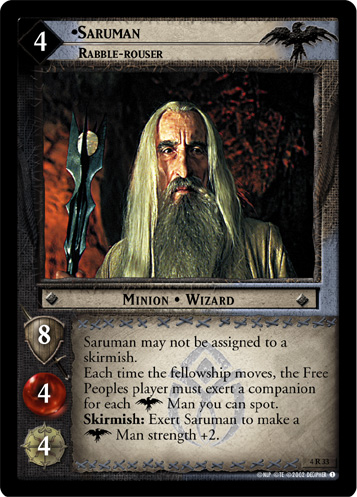 . Along with the Balrog and Sauron himself, is one of the few characters who continues to appear in his original culture after the Shadow cultures are reorganized in the Shadows set. Unlike the Balrog and Sauron, he is the only character who appears in both his original culture as well as the new cultures, as well as the only character who appears in more than one post-Shadows Shadow-alignment culture.
. Along with the Balrog and Sauron himself, is one of the few characters who continues to appear in his original culture after the Shadow cultures are reorganized in the Shadows set. Unlike the Balrog and Sauron, he is the only character who appears in both his original culture as well as the new cultures, as well as the only character who appears in more than one post-Shadows Shadow-alignment culture.
All in all, of all unique characters, Saruman appears in the most different cultures: Isengard,
Dunland,
Men, and
Uruk-hai cultures. (The next closest is Gothmog, who appears in three, followed by Aragorn and many Shadow characters appearing in two.)
| Portrait | Name | Game Text |
|---|---|---|
Saruman, Keeper of Isengard (3R68)

|
Saruman may not take wounds during the archery phase and may not be assigned to a skirmish.
Uruk-hai are fierce. Response: If an Uruk-hai is about to take a wound, exert Saruman to prevent that wound. | |
Saruman, Servant of the Eye (3C69)
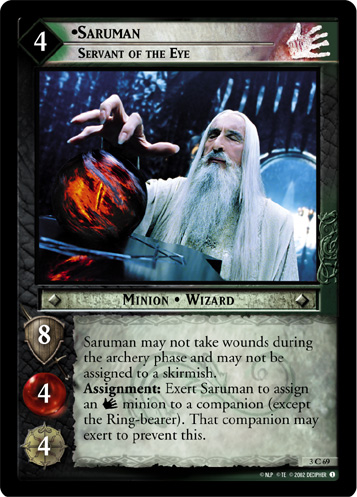
|
Saruman may not take wounds during the archery phase and may not be assigned to a skirmish.
Assignment: Exert Saruman to assign an | |
Saruman, Rabble-rouser (4R33)

|
Saruman may not be assigned to a skirmish.
Each time the fellowship moves, the Free Peoples player must exert a companion for each | |
Saruman, Black Traitor (4R173)
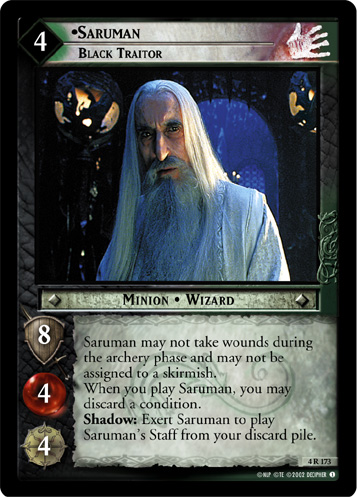
|
Saruman may not take wounds during the archery phase and may not be assigned to a skirmish.
When you play Saruman, you may discard a condition. Shadow: Exert Saruman to play Saruman’s Staff from your discard pile. | |
Saruman, Master of Foul Folk (5R56)
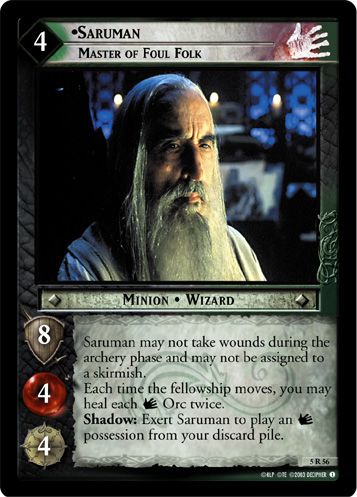
|
Saruman may not take wounds during the archery phase and may not be assigned to a skirmish.
Each time the fellowship moves, you may heal each Shadow: Exert Saruman to play an | |
Saruman, Of Many Colours (12R54)
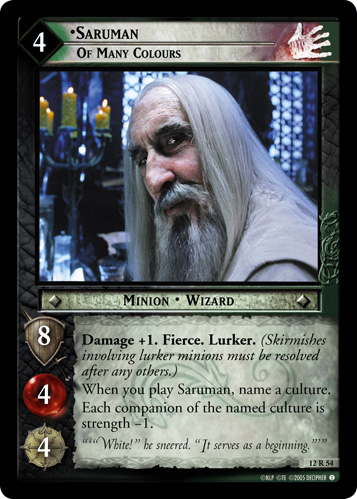
|
Damage +1. Fierce. Lurker. (Skirmishes involving lurker minions must be resolved after any others.) When you play Saruman, name a culture. Each companion of the named culture is strength –1. | |
Saruman, Agent of the Dark Lord (12S144)
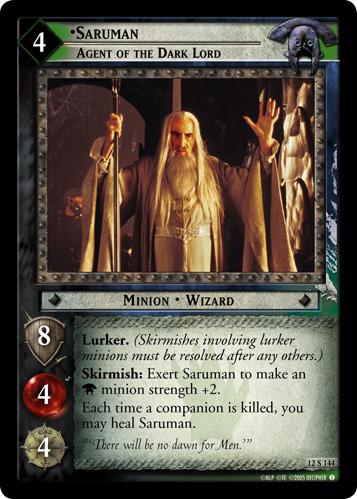
|
Lurker. (Skirmishes involving lurker minions must be resolved after any others.)
Skirmish: Exert Saruman to make an Each time a companion is killed, you may heal Saruman. | |
Saruman, Instigator of Insurrection (17R37)
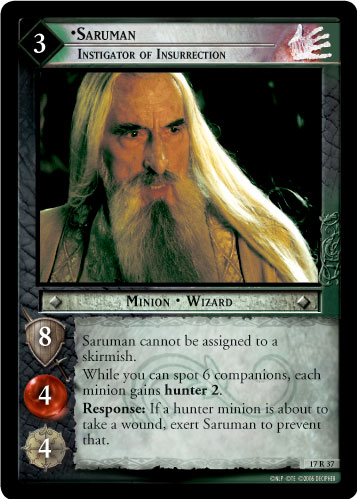
|
Saruman cannot be assigned to a skirmish.
While you can spot 6 companions, each minion gains hunter 2. Response: If a hunter minion is about to take a wound, exert Saruman to prevent that. | |
Saruman, Servant of Sauron (17R38)
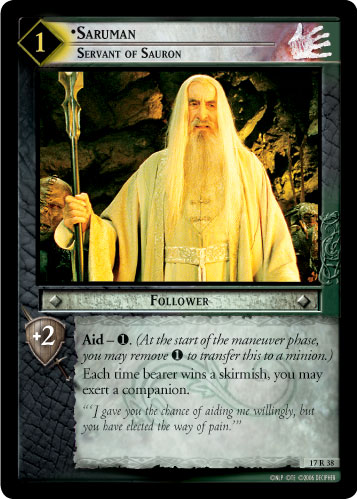
|
Aid - Each time bearer wins a skirmish, you may exert a companion. | |
Saruman, Coldly Still (17S48)
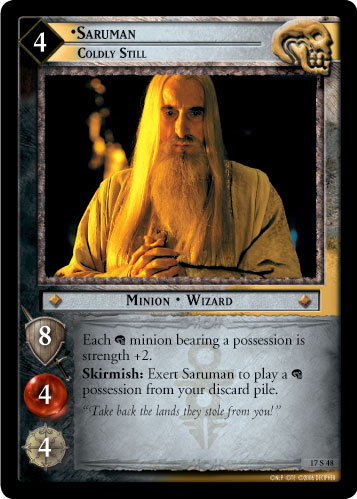
|
Each Skirmish: Exert Saruman to play a | |
Saruman, Curunir (17S115)
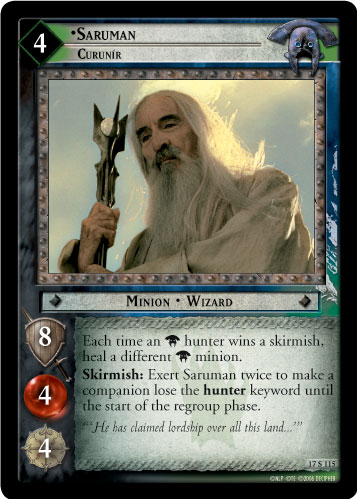
|
Each time an Skirmish: Exert Saruman twice to make a companion lose the hunter keyword until the start of the regroup phase. | |
Saruman, Master of the White Hand (17R116)
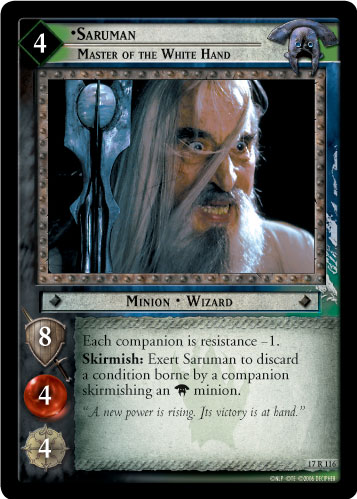
|
Each companion is resistance -1.
Skirmish: Exert Saruman to discard a condition borne by a companion skirmishing an | |
Saruman, Many-coloured Wizard (0D20)
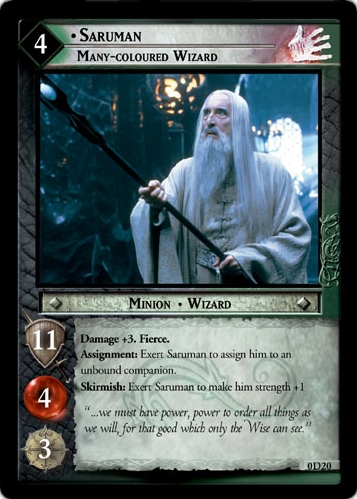
|
Damage +3. Fierce. Assignment: Exert Saruman to assign him to an unbound companion. Skirmish: Exert Saruman to make him strength +1. | |
Saruman, Many-coloured Wizard (0W20)
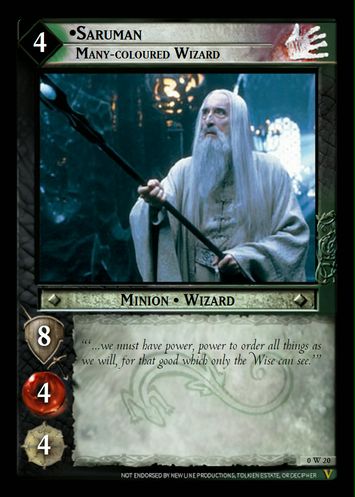
|
||
Saruman, Instigator of Insurrection (0W36)
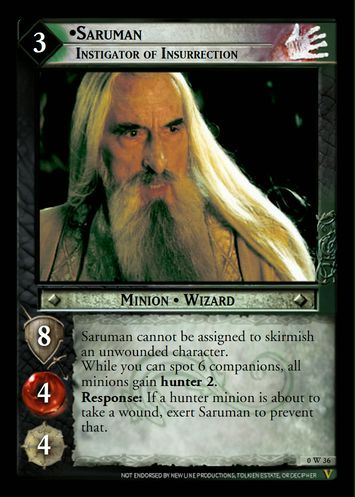
|
Saruman cannot be assigned to skirmish an unwounded character.
While you can spot 6 companions, all minions gain hunter 2. Response: If a hunter minion is about to take a wound, exert Saruman to prevent that. | |
Saruman, Fell Voice (V1_30)
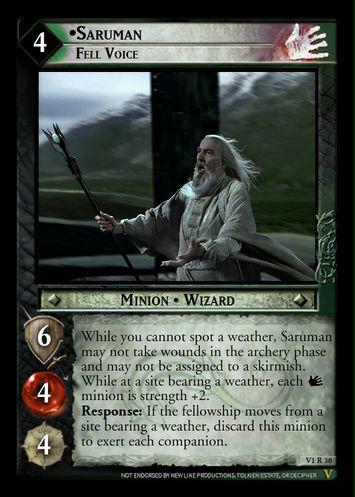
|
While you cannot spot a weather, Saruman may not take wounds in the archery phase and may not be assigned to a skirmish.
While at a site bearing a weather, each Response: If the fellowship moves from a site bearing a weather, discard this minion to exert each companion. |


